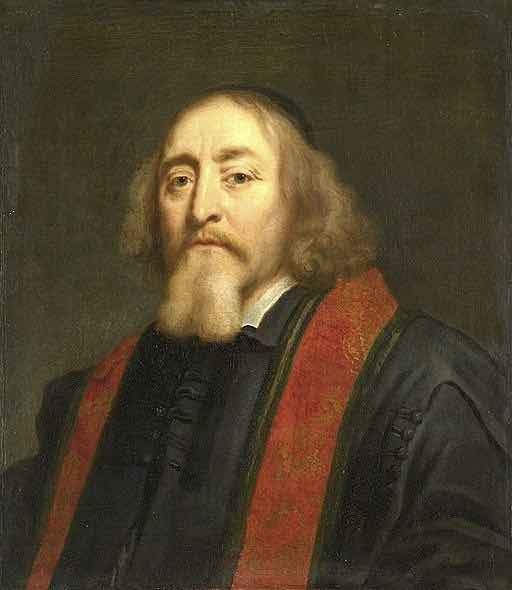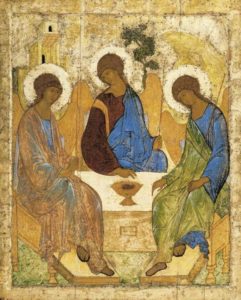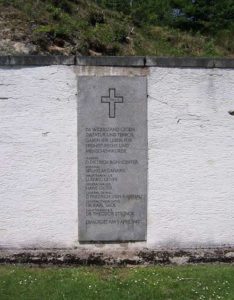The labyrinth of a life
Comenius (Jan Amos Komensky), a committed Christian, a teacher in turmoil
Landscape of Moravia Czech Republic

Jan Amos Komensky (Comenius) was born on March 28, 1592 in Nivnice, near Uhersky Brod in South Moravia (now Czech Republic) into a family of the Church of the Unity of the Bohemian Brethren, the spiritual heiress of John Hus.
After university studies in Germany in Herborn ( 1611-1613) and Heidelberg (1613-1614), he taught at the Latin school in Prerov and then in Fulneck where he was appointed pastor of the German-speaking community.
Under religious persecution
At the beginning of the Thirty Years’ War, the Czech Protestants are defeated by the the Austrian Emperor Habsburg at the Battle of White Mountain near Prague in 1620.
This is followed by a fierce Catholic Counter-Reformation: the political leaders are executed, the Protestant faith is banned, people are forced to convert to Catholicism or to emigrate.
Comenius loses his possessions, his books, his parish and, above all, his wife and two daughters are killed by the pestilence. He remarried two years later.
In 1623, in hiding, he wrote The Labyrinth of the World and the Paradise of the Heart, an allegory that explains his conception of the world.
Emigrant and traveller through Europe
In 1628, he left his country and never returned. He will live through Europe, a complicated life as an emigrant. He experienced the miseries and dangers caused by war and religious hatred. He also knows the fame of his pedagogical and philosophical works among the political powers. He always hoped, but in vain, for help for his homeland.
Pedagogical and linguistic works
From 1628 to 1641 in Lezno on the Polish border, where the refugees of the Brothers’ Unity enjoyed the protection of the Leszczynski Protestant family, he published his main pedagogical works:
– The Open Door of Languages (Janua Linguarum reserata),
– Czech Didactics (Didaktica ceska) (1628-1632) reworked into Latin as Magna Didactica (The Great Didactics), (1633-1638),
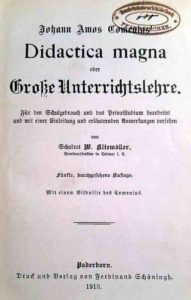
These two works earned him several invitations and stays abroad:
In 1641-42 in London, he took part in work leading to the creation of the Royal Society;
in 1641-1648, in Elbing in Swedish Poland, he wrote several language manuals.
Bishop of the dispersed Unity of the Brothers
in 1648-1650, second stay in Leszno.
In 1648, the Treaty of Westphalia allocates Bohemia and Moravia to the catholic Habsburgs. The latter, according to the principle “cujus regio, ejus religio” (such king, such religion) imposed their religion.
A return of the faithful of the Unity of the Brothers to their homeland is definitively excluded.
In 1650, he was appointed bishop of the Unity of the Brothers, who are dispersed throughout Europe.
From one stay to another: didactic works
From 1650-1654, in Sarospatak at the court of the Rakoczy Calvinist princes of Transylvania, he worked on didactic works,
From 1654-1656, third stay in Leszno: in April 1656 he lost his manuscripts and his library when the town was burnt down by the Polish Catholics.
In 1656 he moved to Amsterdam, where the Senate undertook to publish all his didactic works. He died there on November 15 or 25, 1670.
The paths of The Labyrinth and the Key to Paradise
The Labyrinth of the World and the Paradise of the Heart, contains the key to understanding Comenius’ life choices. We can thus follow the thread of his philosophical and pedagogical thought.
The pilgrim and his two guides
Pilgrims set out to discover the world and the various activities of mankind. He is guided through the symbolic city by two allegorical characters.
– the obnubilator imposes his way of looking at the world
– the ubiquitous discovers everything, sees everything, watches everything.
A terrifying world of manipulation
The conjunction of these two powers results in the image of a terrifying world where the domination of souls is doubly ensured by the manipulation of the external conditions of vision (obnubilation) and by the manipulation of the internal conditions of thought (inquisition). (O. Cauly, Comenius, the Utopia of Paradise)
But ill-fitting glasses
The two characters adorn the pilgrim with magic glasses that make the fake look real, the illusion look real.
But as these glasses are ill-fitting, he can see, obliquely, what is actually happening and how this illusion is produced.
In the court of vanity
The pilgrim, reluctant to all solicitations, remains on his reserve. He arouses the suspicions of his guides who take him before the Court of Vanity, Queen of the World. Having narrowly escaped death, he is tempted to despair of a world that has become a labyrinth with no hope of escape.
The truth from Heaven
However, the masks… are falling off. And the pilgrim suddenly sees the truth in the form of a paradise… …that has taken refuge in the asylum of a pure heart. (Cauly)
Model of the invisible Church and the city of God
It is the model not only of the invisible Church formed by the spiritual community of souls based on the law… of love... but also of a true city of God and men, an effective community that will be reborn in the reunified city (the heavenly Jerusalem), when the time comes. (Cauly)
Comenius, a man not of despair or resignation, but of nostalgia
Comenius, a pilgrim drawn into the labyrinth of distress by the collapse of Europe, particularly of his own nation, during the Thirty Years’ War, is first inhabited by despair before this darkened world. But he will not, however, be content with a paradise of the heart, abandoning the world.
He is not a man of resignation but of nostalgia (vir desiderium) for the paradise, for the Czech paradise. He is waiting for the fulfilment of his desire – the rebirth of the Czech state. He will devote his political struggle to it.
An education reform project to restore society
And through his plan for educational reform, he will prepare for the restoration of a society …destructured by war and threatened in its spiritual identity…
The glorious restoration and beautiful development… of the Church, the State and the entire nation of Bohemia (when it pleases God to restore its sovereignty to the Czech people) will have to be based on a wise and circumspect reconstruction of teaching. (Comenius, Brief Project for the Re-establishment of Schools in the Kingdom of Bohemia)
A global project for the restoration of mankind
But this educational reform is not limited to promoting the rebirth of the Czech nation. It is part of the overall project of restoring man to his original condition, which was affirmed at the beginning of The Great Didactics:
God has decided to revive the paradise of the Church and to transform the desert into a garden of delights… through the institution of an effective right institution to rectify human corruption… And this will be done mainly through the careful and prudent education of youth.
There is no way out of this senseless and cruel world of barbarism and ignorance without education, which leads to the true regeneration of man and of the world, as Comenius will say in Via Lucis :
When the fire of war was burning in the neighbouring countries and from there all of Europe, and everything in Christendom threatened to sink into desolation, I had no other consolation than to see the fulfilment of the ancient divine promise of the light which, at the end of time, would drive back the darkness.
Since human collaboration was to be necessary, it could be nothing else, I thought, but to better instruct the youth of all things (from their natural foundation) and thus to get out of this labyrinth of the world. (Cauly)
An act of political and cultural resistance
Thus, with the Czech Didactics begun in 1628, Comenius posed an act of political and cultural resistance to the new masters of the Czech nation.
They imposed Catholicism as the official religion, pushed the Czech language into the background in favor of German, and under the aegis of Jesuit pedagogy, reintroduced the teaching of Latin in primary schools.
Man as the image of God… on his way to paradise
The Unity of the Brothers was traced back to John Hus.
Comenius developped his theology of infinite perfectibility :
In man and in life there have remained from the divine grace small sparks of light which it belongs (to him)… to rekindle to create a clear light in himself, in the person of others and for all mankind.
The first man fell into the darkness of sin. Through the sacrifice of Jesus, he can try to regain the lost perfection as the image of God, to redeem the fall of the first man by a lifelong and fervent reforming activity. (The Great Didactics)
This will allow him to return to his original state before the fall.
It is more natural for man and easier by the grace of the Holy Spirit to become wise, honest and holy than to follow foreign evil. Indeed, everything easily returns to its nature… not the state of corruption that has characterized us all since the fall… but the first, original condition to which we must all return. After the fall and the punishment, God has grafted… into hearts the cuttings of a new grace. And He sent His son to redeem the original sin… (The Great Didactics)
Man can therefore be brought back to the virtue of God by sure means…, and reflect the perfection of God through knowledge, virtue and religion: this is why we demand the instruction of the Christians of the lineage of the new Adam.…
Indeed, man is the image of the all-knowing God. By his intellectual capacities, he is born capable of acquiring knowledge of things. First of all, because he is in the image of God… And since omniscience dominates among all the qualities of God, necessarily the image of this quality also shines in man. (The Great Didactics)
Every man is educable.
Education, given or received, can bring him out of the labyrinth that separates him from God. It enlightens him by removing the glasses of illusion that distort all perspectives.
Pedagogy participates in restoring in him the resemblance to the image of God, the return to the paradise before the fall.
On this point, a reservation is necessary :
The New Testament states that the full restoration of the original image of God in man begins with the new birth by the Holy Spirit (John 3:3,7; Ephesians 2:8-9.
This is the essential basis for the work of the Holy Spirit to restore God’s image in man, in collaboration with man (Philippians 2:12, 1 Peter 1:10). Comenius must have regarded the first step as implicit.
The right to education belongs to everyone.
Educational institutions, therefore, must be open to all.
All children, nobles or commoners, rich or poor, boys or girls from every town, city or village must be admitted to schools; this is what we must convince ourselves. (The Great Didactics)
At a time when education was still not widespread and especially present among the wealthiest, Comenius takes up Luther’s wish in his Manifesto to the Cities of the Empire in 1525. He urges the establishment of schools at public expense to educate the youth of both sexes. Even those destined for the workshop or the fields should … receive regular literary, moral and religious instruction. (The Great Didactics)
No one should be excluded from education.
Girls have access not only to primary education but beyond:
No reason justifies the exclusion of the weaker sex (I insist) from study, whether it be in Latin or in a common language… Women are also in the image of God…; they are endowed with a keen intelligence and an aptitude for knowledge equal or even superior to our own…(The Great Didactics)
And also children with low intelligence, perhaps even mild mental disabilities…
It will be said again: there are spirits so stupid that it is impossible to introduce anything into them. I answer: certainly there are dirty mirrors that reflect images badly…But you must start by cleaning the mirror…Then it does not refuse to play its role (The Great Didactics)
Educating with differences in mind
However, the pedagogue has no illusions about the general educability of man. He knows that there are sometimes considerable disparities between individuals, and this must be taken into account.
But it is possible to instruct and educate such a diversity of characters with a single method because … all men, over and above differences in intellectual ability, have one and the same human nature whose organs must be educated. (The Great Didactics)
The child, from the labyrinth of the humanist school to the paradise. The Great Didactics
A real practice of education and a real knowledge of child psychology
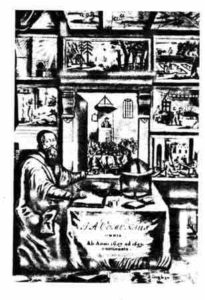
Comenius’ pedagogy goes beyond its ethical and religious bases, with the aim of regenerating man and getting him out of the labyrinth.
It does not remain abstract conceptions, but is based on a real practice of education and a real knowledge of child psychology.
A positive image of the child
The positive image he gives of the child, also in the image of God, is in contrast to the negative view of the child that was generally held in the 17th century.
Traditionally, the child was considered evil, inclined to evil and had to be submitted to an authority that could go as far as repression.
Rooted in the Protestant tradition of Bohemia
This positive conception of childhood, unusual in the 17th century, is rooted in the old Protestant and revolutionary tradition of Bohemia. The utopian (and angelic) vision of the purity of the child thus made it possible to criticize the corruption of man and the established powers…(Cauly)
The child, the most precious property to educate…
To Berullius, who asserted that “childhood is the vilest and most abject of human nature after that of death”, Comenius replied that there is nothing greater or more estimable because it is, with the exception of original sin, the uncorrupted image of God. The child is the most precious good which it is man’s duty to educate. (Cauly)
He underlines this divine presence in a passage from the dedication of the Great Didactics. In it he describes children as masters and models for adult people.., because in them are found the simplest and most suitable dispositions for receiving the improvement that divine mercy brings to desperate human causes. (The Great Didactics)
Traditional teaching in the 17th century
Overcrowded classrooms with students of all ages
Teaching in the 17th century was carried out in overcrowded, totally heterogeneous classes.
Children from the upper social classes entered secondary school at the age of five, then nine years old, but those from the common people between the ages of twelve and fifteen.
In a fifth grade class of the Jesuit college of Chalons (1618-1620), there were 165 pupils between the ages of 8 and 18.
(Etienne Krotky,Forming Man)
https://books.google.com
No attention to children’s level of maturity
Secondly, no account was taken of the level of psychological and intellectual maturity of the children. It was believed that they had the same mental mechanisms and were capable of the same performances as adults.
An aberration: learning the mother tongue from Latin
Comenius denounces the aberration of teaching children their mother tongue from Latin.
He recalls the anguish of the pupil, his own anguish too when he was a pupil in the Latin school, crushed under the labyrinth of a mass of rules, comments, comparisons of texts, controversies, gorged with Latin grammar including exceptions and irregularities… dazed because unable to know what the meaning of it all is. (The Great Didactics)
Worse, as soon as they had learned to decipher the Greek alphabet, and while they still did not know the basics of the language, they were given grammars that showed dialectal grammatical differences. (Krotsky)
Studying difficult authors too quickly
He also criticizes a habit of Latin schools to switch to authors as soon as students have tasted the grammar rules. But to which authors?
The schools that want to give the impression that they are the best, go straight away … to Cicero, to Virgil and he advises to take the examples of grammar in everyday life. (Krotsky)
Torturing, disappointing methods of education…
He also criticizes teaching methods for being so harsh that children see school as a scarecrow and a torture chamber for the mind.
Most of them feel nauseous at the sight of letters and books and would rather run off to work at craftsmen’s shops or do anything else than to get mere disappointing results. (The Great Didactics)
And ineffective
The washerwoman, the craftsman… learn any new language, even several, in less time than it takes schoolchildren learning Latin full time and with all their might… But still not able to express themselves without… a grammar or a dictionary after fifteen or twenty years of study. (The Great Didactics)
The Great Didactics: a new school organization
It takes into account the age of the children and their level of psychological and intellectual development.
For Comenius, man does not become an adult until the age of about twenty-four, with four stages of development lasting approximately six years each, characterised by the maturation of a faculty or of particular possibilities:
Four stages of development
– early childhood -INFANTIA -(from birth to 6 years) – stage of the external senses and motor skills;
– infancy -PUERITIA -(from 6 to 12 years) – stage of the internal senses: awakening of the mental representation of things;
– Adolescence -ADOLESCENTIA -(12 to 18 years of age) – stage of the faculty of judgement and reasoning;
– youth -JUVENTUS -(from 18 to 24 years of age)-stage of the development of pure understanding and will (Comenius, The New Method of Languages – Methodus Linguarum Novissima).
Four teaching cycles
These four stages correspond to four cycles of education open to all, boys and girls, at least up to the age of 12:
– for early childhood, the school of the maternal bosom,
– for children, public elementary school, in their mother tongue,
– for teenagers, Latin school and gym, (high school)
– for youth, the Academy (University) and travel,
with nursery schools in every house; elementary schools in every town… a gymnasium in every city, an Academy in every kingdom or even in every large region. (The Great Didactics)
Homogeneous teaching given equally to everyone
In the past, teachers used to be exhausted by teaching one person individually and braying at others who were idle … and ignorant. They dissociated naturally related subjects, such as reading and writing, and students used different books on the same subjects. (The Great Didactics)
Now, according to the model of the sun which illuminates the whole earth in the same way, a homogeneous teaching is given in the same way to all, by a single master with the same book and the same methods for each subject.
It will be based on solid and concise basic notions. It will follow a progression according to which each new knowledge reinforces the one that precedes it and opens the way to the one that follows it. (The Great Didactics)
A single teacher will thus be able to teach a class of about a hundred pupils simultaneously.
– by dividing the class into groups of ten students with instructors
– never giving private lessons but always group lessons,
– by placing himself in such a way as to be seen and heard by all at once.
The Eight Principles of the Model Lesson
The author then gives the eight principles of the “model lesson” which enable the teacher to awaken and maintain the attention of the pupils and explains the procedures for mutual correction of written exercises.
A new teaching method
easy and enjoyable so that both students and teachers are not disgusted (with the work) before they even tackle it and before they see the results.
May the school cease to be a labyrinth, a prison, a prison and a place of distress, and may it begin to be a stadium, a palace, a feast and a paradise” which will allow “to get out of the school labyrinths”, according to the title of one of his treatises. (Krotsky)
Foundations for easy teaching and study
In chapter XVII of The Great Didactics, entitled Foundations for an easy teaching and studying, he asks the teacher
– to awaken in students the desire to know and to learn
– to choose a teaching method that reduces the student’s fatigue and prevents him from turning away from study out of fear (The Great Didactics).
We do violence to the understanding (intelligence)
– whenever the student is forced to perform a task beyond his or her age and strength
– Whenever he is required to memorize poorly explained or poorly worded things and when he is required to do an exercise that is too briefly presented,
And also when we make him learn words he doesn’t understand.
Natural motivations drive man to seek knowledge
Comenius insists on the natural motivations that drive man to desire to acquire knowledge. Thus,
It is not necessary to force the eye to open to stare at objects because, spontaneously thirsting for light, it takes pleasure from itself in looking.
In the same way our mind thirsts for objects…It captures everything without fatigue as long as you proceed clearly, in the order it needs and one thing at a time. (The Great Didactic)
Knowledge begins with the senses
… since nothing can reach intelligence except through sensation, knowledge must necessarily begin with the senses… Only when the observation of these things has been conducted will the word intervene to explain them profitably. (The Great Didactics)
For the young child, discovery of the world through the observation of objects
Comenius involves young children in discovering the world by making them observe the objects that make it up:
Through the external senses, he will teach from kindergarten onwards to distinguish and name animals, elements of nature such as water, wind,… body parts and to find his way through time.
If direct observation of things is impossible, a picture book will be used.
For the older child, develop sensitivity, imagination and memory.
For the older child, internal sensitivity, imagination, memory will be develope d in elementary school along with the organs of execution, the hand and the language for reading, writing, drawing…arithmetic, surveying…and other exercises that work the memory. (The Great Didactics)
A complete education program for intelligence, language and hand
He therefore offers a complete educational programme that exercises intelligence, language and the hand at the same time and enables the child to acquire notions and principles through the observation of the concrete, real or imaged.
The World in Pictures, the first illustrated school book
in application of the Comenius pedagogical principles
The World in Pictures (Orbis sensualium pictus quadrilinguis), published in 1652, is the first illustrated school book. It is the most complete practical application of Comenius’ pedagogical principles.
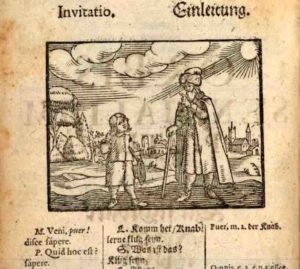
with an encyclopedic subtitle:
The painting and nomenclature of all the fundamental things and main actions of human life
a compendium of the whole world and the whole language ... but also a pictorial and pedagogical compendium, embellished with paintings, nomenclatures and descriptions. (Collection of excerpts from the pedagogical work)
Correspondence between the illustration and the name of the object by means of numbers
It makes it possible to establish the correspondence between the illustration representing an object or concept and the name they bear. Indeed, the words in the text carry a number that corresponds to the image in which the object is represented.
From simple to complex
The book goes from the simple to the complex, with an introduction to the trades, as shown in the illustration and text on the print shop.
With an illustrated alphabet
Preceded by a symbolic alphabet that accompanies each letter with the figure of an animal whose natural voice seems to imitate its sound, it will be useful for learning the mother tongue, and since words translated into other languages (German) are placed next to Latin words, it will help to understand the Latin language better and more easily. (Collection of excerpts from the pedagogical work)
The basis of today’s children’s encyclopaedias
The World in Pictures was published until 1910. Today, the principle is still found in children’s encyclopaedias with simple, clear, and colourful illustrations, words to designate things, and an explanatory text.
For the teenager, to train judgment, intelligence and will power.
To observe, compare, discover the reasons for things
Comenius also asks the adolescent to observe things, but above all to compare them and try to discover the reasons for them.
We will move from practice to theory through the study of dialectics, grammar and rhetoric.
This is how judgment and reflective intelligence of all that is perceived by the senses will be formed.
Finally, the Academies will cultivate above all that which relates to the will…so that it may exercise its legitimate power over all things. (The Great Didactics)
No teaching with words and opinions gleaned from books.
Showing how things exist on their own
He rejects the “proxy” teaching of his day, which consists of filling the mind with a jumble of words… and opinions gleaned here and there from books; instead of awakening the intelligence by putting students in the presence of things, showing them how they exist in and by themselves. (The Great Didactics)
Making studies easy and interesting: going from the general to the particular, from easy to difficult
At the same time, he seeks to make studies easy and interesting according to the principles of the beginning of chapter XVII of The Great Didactics. Among other things it was necessary to go from the general to the particular, from the easy to the difficult. But this was not applied to the teaching of Latin.
For the teaching of Latin to beginners, rules were given in Latin
Beginners in Latin were given the rules of the language in Latin…….a Latin -vernacular language lexicon, when it should be the other way around; it is not their language that they should learn but Latin…..a foreign master who does not know their language (The Great Didactics).
Instead, explanations should be given in the student’s language and examples should be taken from the student’s environment to illustrate the new rules.
The Open Door to Languages (Janua linguarum reserata)
A Latin textbook based on the mother tongue
It is according to these precepts that Comenius wrote The Open Door to Languages (Janua linguarum reserata). The first edition appeared in 1631.
It is a Latin textbook that takes the mother tongue as its starting point.
1,000 simple sentences with 8,000 Latin words and their translation into the mother tongue.
It consists of a thousand simple sentences about the surrounding world, made up of eight thousand Latin words put in order, with the same word in the mother tongue facing each other.
Small encyclopedia of nature and the surrounding world
It is also a small encyclopedia that will put the student in contact with the phenomena of nature and the different facets of the world around him.
A walk through the world created from the beginning to the Holy Trinity.
The course of things is presented … through a walk taken by the child in the company of the author who guides him in the created world, from the origin of things to the Holy Trinity through all spheres of life. (Cauly)
100 short scenes from daily life in 100 sections :
Short scenes of daily life are clearly and distinctly presented to the child’s mind and distributed in 100 rubrics (or “Common Titles of Things”) that reveal a methodical progression:
from creation to the different worlds (mineral, vegetable, animal) through the different spheres of social and economic life, then cultural life, until the last end of existence. (Cauly)
The work was quickly translated into several languages, including a French and Latin edition in 1642.
Paradise regained?
Comenius is a fascinating author of great richness and complexity. He exercised his talents in many fields: pedagogical, philosophical, religious and political. He aroused the admiration of many, but he did not enjoy unanimous support and attracted criticism and enemies.
The recovery of the Czech nation?
For example, he put too much faith in the pseudo prophecies of atypical or unsavory people announcing the restoration of the Czech nation, which were contradicted by the facts.
One could excuse him by saying that he symbolized the hopes of a persecuted people, on the run, given over to political games and betrayals.
Indeed, the hope raised by Sweden’s support was immense, its armies were about to occupy Prague.
But the announcement of the Treaty of Westphalia put an end to the conquest that would have fulfilled the prophecies of return. However…
When the Treaties of Westphalia (1648) confirmed foreign domination over Bohemia, Comenius, in “The Testament of Unity, dying mother”, uttered this cry that sounded like a challenge:
“0 Czech people, the day will come when you will once again have the government of your affairs in your own hands”.
This faith in the return of national independence will be the support of Czech patriots in the nineteenth century. And when the time for independence came in 1918, the president-liberator, Masaryk, referred to this “prophecy” in his first solemn address to the nation (Krotsky).
Passion, generosity, hope in God
If we consider the whole life and motivations of Comenius, we cannot help but read in it passion, generosity and an immense hope in God.
No revolt in spite of misfortune. God is the rock of his life
The misfortunes of his homeland and his personal suffering could have ruined his faith and driven him to revolt.
But, speaking of God after the fire of Fulneck and the death of his wife and children, he will say that he is the “rock of his life”, a “strong tower”.
And when he loses his manuscripts – forty years of work – in the fire of Lezno in 1656, he says that he “had lost everything except this one, which alone is everything” (Krotsky).
There is something prodigious and authentically Christian in the contrast between the sufferings and ferocities endured by Comenius and the mystical joy from which these texts written in poverty and exile radiate.
(Marc Fumaroli, From the Paradise of the Heart to the College of Light: The visualisation of things and the philosophical conception of the world in the work of Comenius)
Concern for training for the people of his time who were left in ignorance.
He had a genuine concern for the mass of people of his time, who were left to intellectual, moral and spiritual ignorance by the neglect of political powers and the vicissitudes of war. He was convinced that good schools could remedy these shortcomings. Only he felt in his time that “the art of forming men was one of the deepest mysteries of the world and of our salvation” (Krotsky).
An assessment, at least a summary one, of its education system?
Almost ignored in the French public education system
Rousseau is credited with his conception of the psychological development of the child and his educational system.
A first fact: Comenius is almost totally ignored in the world of public education. Rousseau has been credited with the authorship of his conception of the psychic development of the child and of his educational system.
It would be … easy to show how Rousseau often repeats Comenius; sometimes we “find the expressions of Comenius verbatim”. (Krotsky)
More notoriety today… in specialist meetings
He is a little better known today but his fame is limited to the circle of symposium specialists.
The only biography available in French until relatively recently was that of Anna Heyberger, published in 1928.
A truncated Great Didactics, eliminating any religious dimension…
As for The Great Didactics, it has been translated twice.
The one published by Editions Klincksieck in 1992 fortunately replaced that of Piobetta in 1942 at the P.U.F.
The latter, under the aegis of secularism, recovers the “pedagogical advantages” of Comenius by eliminating any religious dimension.
The first chapters of The Great Didactics and other passages are simply ignored and words like God, religion replaced by suspension points!
Reproaches of making study easy and inciting laziness
Some have criticized him for wanting to make study easy and thus encourage students to be lazy.
But his aim is actually to make the culture reserved for the elite accessible to the people.
We must not forget his objective of making accessible to the people the culture hitherto reserved for the elite, while avoiding putting them off by too many difficulties.
“It is always necessary to choose, as far as possible, means that are easy to use (what is difficult will pass for impossible). … “Whatever you undertake, you must have safe means and an easy method to put it into practice”. (Krotsky)
At the same time, the Jansenists of Port Royal
He was not the only one working on better language teaching and teaching methods that were less off-putting and more accessible to students.
The titles of books written during the same period by the Jansenists in Port Royal bear witness to this.
– New Method to Learn Easily and in a Short Time the Latin Language (1644)
– New Method to Learn Easily and in a Short Time the Greek Language (1657) from Lancelot. (Krotsky)
Evaluating the notions of ease and difficulty in accordance with the conditions of the time.
It is also important to evaluate the notions of ease and difficulty in relation to the conditions of his time – especially the teaching of Latin given in Latin – and not to compare it with the present conditions of teaching.
Easy for a pupil of the Comenius school meant “a little more accessible”, whereas in some areas and requirements of today’s teaching it sometimes means “elementary” or “destitute”.
Comenius: culture for all strata of society
Diderot and Voltaire: Conservatives without sympathy for the people
Comenius was the first to work to spread culture to all strata of society because he respected the image of God in every human, whereas Diderot or Voltaire “were conservatives without sympathy for the popular masses who sometimes inspired them with very harsh words”. (Krotsky)
Right to education for the disabled, the intellectually disabled and those thought to be enslaved
He also grants the right to education to the intellectually disabled and handicapped and also to those who were then called “barbarians” and thought to be soulless and therefore reserved for slavery.
Conclusion by Comenius
We will leave it to Comenius himself to draw the conclusion that links the fundamental elements, options and achievements of his life
In the book School as a Game (Schola ludus), he described himself as follows in 1657:
“Moravus sum natione, lingua Bohemus, professione theologus ad Evangelii ministerium. My nationality is Moravian, my language is Czech, my profession is Czech, and I am a theologian at the service of the Gospel. »
As for his research in didactics, he writes clearly
What I wrote for young people, I did not write as a pedagogue but as a theologian. (Opera didactica omnia IV, 27).
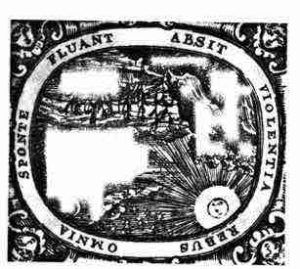
Illustration taken from the “Complete Didactic Works” with the inscription Everything flows from oneself, violence is absent from things.
